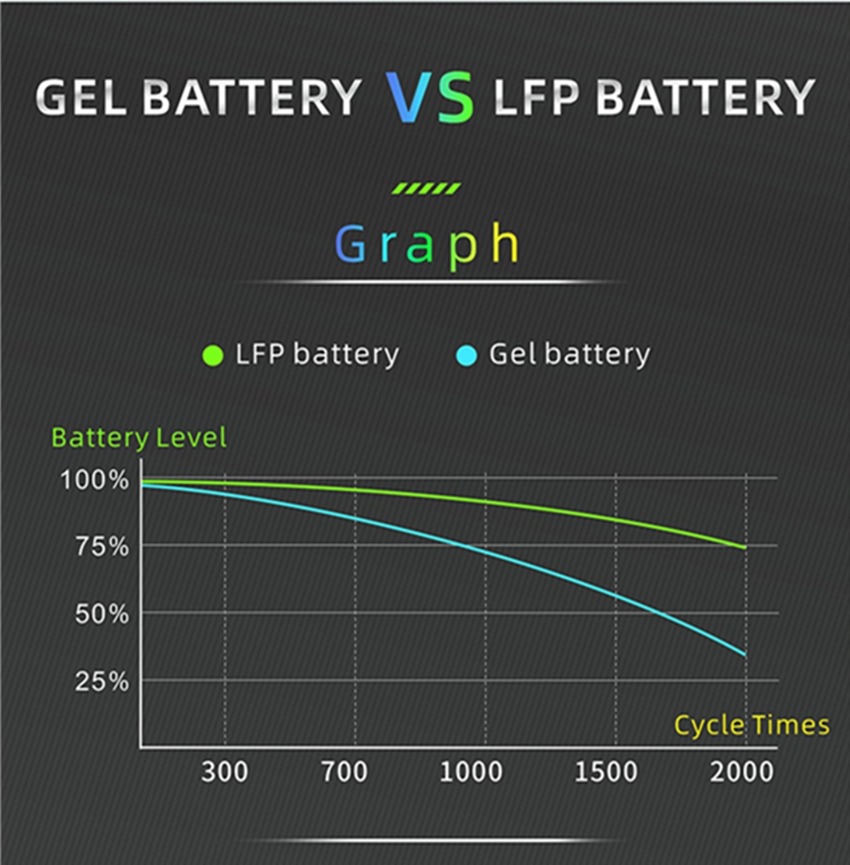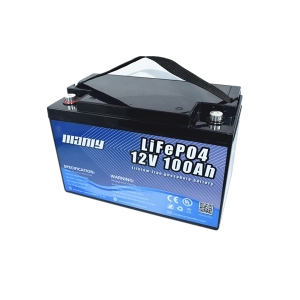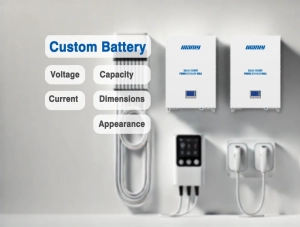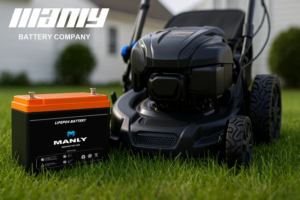LiFePO4 frente a iones de litio: la mejor batería para usted
Tabla de contenido
- LiFePO4 frente a iones de litio: la mejor batería para usted
- 1. ¿Qué es la batería LiFePo4?
- 2. Comparación de las diferencias químicas entre LiFePO4 y las baterías de iones de litio
- 3. LiFePO4 frente a baterías de iones de litio: una comparación detallada de su rendimiento
- 4. Baterías LiFePO4 comparadas con alternativas sin litio: una descripción general completa
- 5. Elegir entre baterías LiFePO4 y de iones de litio: encontrar la que mejor se adapte a sus necesidades
- 6. Exploración de la versatilidad de las baterías LiFePO4 en diversas aplicaciones
1. ¿Qué es la batería LiFePo4?
The LiFePO4 lithium iron phosphate battery is a modern, safe, and efficient type of lithium battery. This rechargeable battery is popular for its long-lasting power. Being new and cutting-edge, the LiFePO4 lithium iron phosphate battery leads in lithium tech. Its unique chemical make-up is its strength. Unlike common lithium-ion batteries, used LiFePO4 cells don't contain nickel or cobalt. This makes them safer and more eco-friendly. LiFePO4 battery cycles are used in many things. They're found in off-grid power storage, backup power systems, small electronics, and electric cars.2. Comparación de las diferencias químicas entre LiFePO4 y las baterías de iones de litio
LiFePo4 and Li-ion batteries are rechargeable batteries that use lithium ions to harness and release electrical energy. While they are similar in many ways, they also exhibit some glaring differences.batería de fosfato de hierro y litio lifepo4
The LiFePO4 lithium iron phosphate battery is a special type of lithium-ion battery. This battery uses a unique mix of chemicals. It is now more used in off-grid and backup power.LiFePO4 lithium iron phosphate batteries get their name from their special cathode. The cathode is made of lithium iron phosphate. The anode is usually carbon. The electrolyte is a lithium salt in an organic liquid. The energy of this battery is 90/120 watt-hours per kilogram. The usual voltage is 3.20V or 3.30V. The battery can be charged at 1C and discharged at 1-25C.The LiFePO4 battery is safer than other lithium-ion batteries. It is made with iron, phosphorous, and oxygen. These things bond together strongly. This makes the battery stable and less likely to get too hot.The LiFePO4 battery does not use nickel or cobalt. These metals are running out and often come from bad sources.Baterías de iones de litio
Lithium-ion batteries have different kinds of chemicals in them. They can have lithium iron phosphate (LiFePO4), lithium manganese oxide (LMO), or lithium cobalt oxide (LiCoO2).These batteries have three main parts: a cathode, an anode, and an electrolyte. The electrolyte is made of lithium salt. The anode is made of carbon. The cathode is different in each battery. It is made of one of the lithium metal oxides.Lithium-ion can store 150/200 watt-hours per KG of energy. Its voltage is 3.6. It can be discharged at 1C and charged between 0.7C and 1.0C.All these batteries charge and discharge the same way. The lithium ions move from the cathode to the anode. Electrons move the other way. This makes electricity.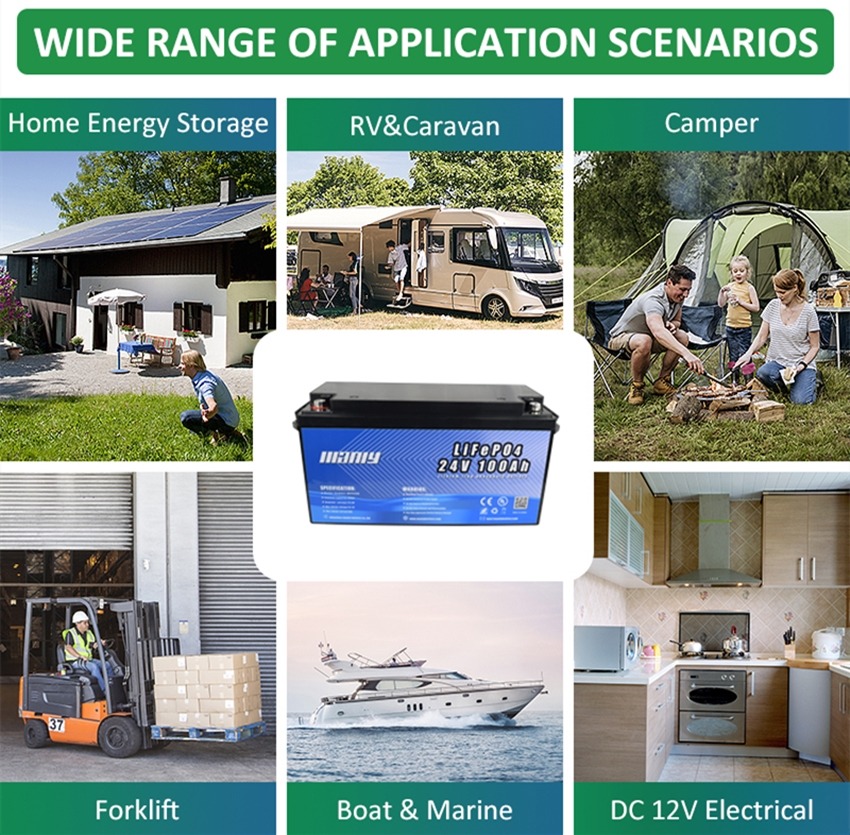
3. LiFePO4 frente a baterías de iones de litio: una comparación detallada de su rendimiento
seguridad
LiFePO4 lithium iron phosphate batteries are the safest kind of lithium batteries. This is because lithium iron phosphate is more stable than other materials. Lead acid and other batteries are not as stable as LiFePO4.LiFePO4 does not burn. It can handle high heat and it doesn't break down. It doesn't get too hot, even at room temperature.A LiFePO4 battery won't catch fire or explode if it gets very hot or damaged. This makes people feel safe. They use these batteries every day in RVs, boats, scooters, and liftgates.Lithium-ion chemistry is not as safe as lithium iron phosphate. It has lots of energy, but this can make the battery unstable. A lithium-ion battery can get too hot when it charges. It can experience escapes térmicos, lo cual no es seguro.Densidad de energia
Li-ion batteries can hold more energy than LiFePO4 lithium iron phosphate batteries. Energy density shows how much energy a battery can hold for its size or weight. Li-ion batteries can hold more power for their size or weight than used LiFePO4 cells.For example, a Li-ion battery can hold about 45-120 Wh per pound (100-265 Wh per kg). But, a LiFePO4 battery can hold about 40-55 Wh per pound (90-120 Wh per kg). The reason why Li-ion batteries can hold so much energy is that there are many types, including ome types are only used in electric cars and other things.Peso
The weight of a battery can tell you its energy density. LiFePO4 batteries might weigh a bit more than some Li-ion batteries. But some LiFePO4 batteries are lighter because they use lighter metals. They are almost 50% lighter than lithium manganese oxide batteries. They are even up to 70% lighter than lead acid batteries.High energy Li-ion batteries like nickel-cobalt-aluminum (NCA) and nickel-cobalt-manganese (NCM) are not the best for off-grid and solar use. People prefer to use safer and longer-lasting batteries like LiFePO4 for home power. Safety is more important than a small difference in weight.Even though used LiFePO4 cells are safe and last long, they are still light. They hold a lot of power for their weight. The Manly 12v100ah lifepo4 battery can hold 1280 Wh of energy. It only weighs 47.3 lbs (21.5 kg). This is light enough to save weight on your scooter, boat, RV, or industrial use.Rango de temperatura
LiFePO4 lithium iron phosphate batteries work well in many temperatures. They can work from -4°F (-20°C) up to 140°F (60°C).But, Li-ion batteries can only work from 32°F (0°C) up to 113°F (45°C). People must keep Li-ion batteries in places with controlled temperature in hot or cold weather.LiFePO4 batteries can be kept safe in a home, shed, garage, or inside without air conditioning. They handle temperature changes well. This means you can store the battery in many places without it getting hurt or working less. For example, a Manly Battery can have a custom lifepo4 BMS. The BMS will stop if the temperature gets over 167°F / 75°C.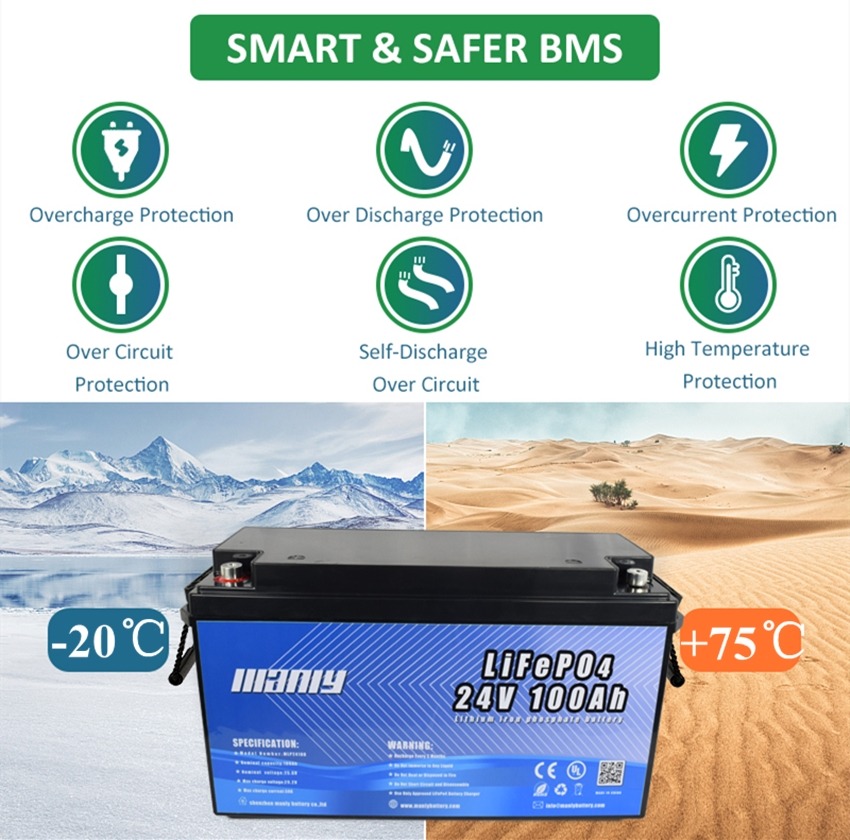
Esperanza de vida
Lithium-ion batteries have lots of energy. But, this can make them unstable, especially in hot places. They can be charged and used from 500 to 1,000 times. However the temperature can affect how they work.Lifepo4 lithium iron phosphate batteries can be charged and used 1,000 to 10,000 times. They can handle high heat and still work well. They can keep working for a long time before they need to be charged again.The long lifepo4 battery lifespan helps the environment. It reduces e-waste. These batteries are also good for the environment because they don't have nickel or cobalt.Your lifepo4 battery can last 5 or 6 times longer than a lithium-ion one. This means you won't need to buy new batteries as often.4. Baterías LiFePO4 comparadas con alternativas sin litio: una descripción general completa
Baterías de plomo ácido
- Respetuoso con el medio ambiente: las baterías de fosfato de hierro y litio LiFePO4 no contaminan (no son absolutas), mientras que las baterías de plomo-ácido contaminan con plomo de metales pesados.
- Seguridad: La seguridad de las baterías de iones de litio varía según los diferentes materiales, mientras que la tecnología de las baterías de plomo-ácido es bastante madura y más segura que la de las baterías de iones de litio.
- Relación energética: Las baterías de iones de litio tienen aproximadamente un 40% más de capacidad energética en peso y volumen que las baterías de plomo-ácido.
- Precio: El precio de una batería de iones de litio con la misma capacidad es más del doble que el de una batería de plomo-ácido.
- Vida útil: actualmente, el LiFePO4 general se puede cargar 1500 veces sin efecto memoria. Después de 1500 cargas, tiene aproximadamente un 85% de capacidad de almacenamiento. Por el contrario, las baterías de plomo-ácido duran unas 500 veces y tienen un claro efecto memoria.
- Tasa de autodescarga: las baterías de fosfato de hierro y litio LiFePO4 tienen una tasa de autodescarga mensual de <3%, mientras que las baterías de plomo-ácido tienen una tasa de 15~30%, una clara diferencia.
- Características de descarga: En pocas palabras, para baterías de la misma capacidad, las baterías de iones de litio pueden descargar aproximadamente un 30% más de electricidad bajo descarga de alta corriente que las baterías de plomo-ácido.
- Plataforma de voltaje: La plataforma de voltaje de las baterías de fosfato de hierro y litio LiFePO4 es> 3 V, mientras que la de las baterías de plomo-ácido es de 2 V.
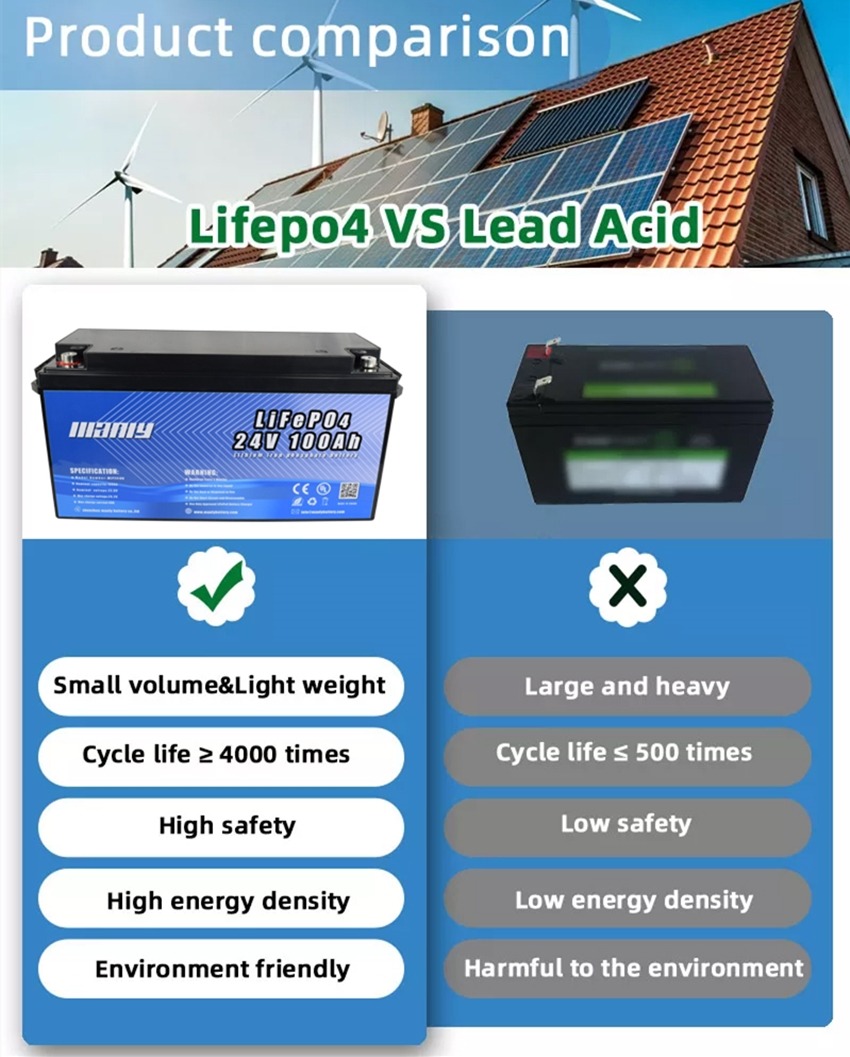
Baterías de gel
First, let's talk about lifespan. Gel batteries have a lifespan of around three hundred cycles, while LiFePO4 lithium iron phosphate batteries can reach up to three thousand cycles! They far outperform gel batteries!Next is energy density. Each kilogram of LiFePO4 lithium iron phosphate battery can reach one hundred and fifty watts per kilogram. The maximum density of gel batteries does not exceed one hundred watt-hours.